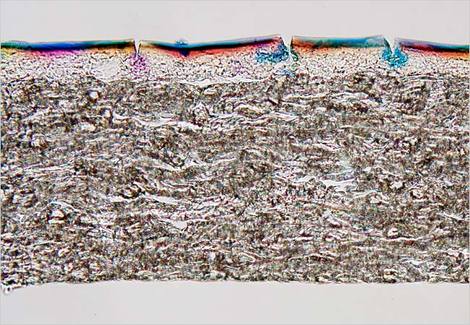
A sample of surface cracking on a dye-base inkjet print. Photo: Image Permanence Institute, R.I.T.
by Ian Austen, The New York Times
The preservation center at Canada’s national archive here might have the last word when it comes to keeping the color in color photography. A four-story concrete building, which is enclosed within a second protective building, holds two warehouse-size vaults where negatives, prints and film are kept in the dark at 0 degrees and 25 percent relative humidity. Before anything in the collection can be examined, technicians must put it into an acclimatization chamber that resembles an oversize stainless-steel refrigerator, where it is warmed up over a 24- to 48-hour period. Henry Wilhelm, an American researcher on photographic preservation, says the complex and costly system is worth the trouble.
“Those images should last thousands of years,” he said from his office in Grinnell, Iowa. “Imagine seeing photos of the building of the pyramids.”
But even officials at the archive are uncertain how to manage the medium that now dominates photography: inkjet prints....
_____________
Oren Grad



Interesting article, but it seems some things are off.
"pigments cannot be used on glossy paper without special functions"
It seems that the paper manufacturers like Innova know something the author of the article doesn't:
http://www.innovaart.com/product.php?id=15
http://www.innovaart.com/product.php?id=21
Is that a "special function"? I'd consider something like the clear fixing ink in HP's Z series printers to be a special function.
Posted by: erlik | Thursday, 07 June 2007 at 02:13 AM
Mike,
Interesting article. However, with respect to this quote:
"Conventional black-and-white prints, which are made up of tiny grains of silver, remain the undisputed longevity champions." - I make platinum/palladium prints on acid free cotton rag paper - surely these are the king for longevity
Posted by: Ger Lawlor | Thursday, 07 June 2007 at 04:29 AM
Interesting that they show surface cracking in the photo. Virtually all historic albumen prints have surface cracking, but many of them have managed to survive for 100-140 years now. Most of those cartes de visite and cabinet cards from about 1865-1900 on thin paper, always mounted to a heavier cardstock, that one finds in boxes at photo swaps and flea markets are albumen prints.
On the other hand surface cracking is probably more detrimental to an inkjet print than to an albumen or gelatin silver print, since the dyes are more vulnerable to exposure to air and pollutants than silver is.
Posted by: David A. Goldfarb | Thursday, 07 June 2007 at 08:13 AM
It is always unclear to me what "lasting" means in this context. I can imagine it meaning:
1) no discernible change;
2) no worse than a 100 year-old silver print;
3) original image still visible/discernible;
4) some shift/fade, but subjectively acceptable.
Also: it would really be helpful to have an understanding of what test results meant in real world storage conditions. At the moment, I am printing pigment (K7) prints on a variety of papers (acid-free matte paper, Costco "Kirkland" glossy, HP Premium glossy) and storing prints in the original cardboard paper box. Doesn't sound optimal, does it? But how is one to know about print longevity, when the tech cycle of a printer/ink combination is measured in months rather than years? Makes me want to dig out a used D2 enlarger and stock a chest freezer with silver based materials.
Ben Marks
Posted by: Ben Marks | Thursday, 07 June 2007 at 09:29 AM
FUD is an acronym that originated with Gene Amdahl in the computer industry. It stands for Fear, Uncertainly, and Doubt. The point of FUD is to appeal to people's fears in an attempt to persuade them to do what you want which is usually to maintain the status quo.
In this case saying that inkjet prints are bad because they'll fade (without mentioning that all prints fade regardless of print method, and pigment inkjet prints fade less then most) is an attempt to persuade the reader to use and/or buy "conventional" prints. You read that article and you come away thinking that these upstart inkjet prints are bad and that if you want less fade you need to stick with a tried and true technology like C-prints. The fact that C-prints have considerably less longevity than pigment inkjet prints isn't made clear at all. And that,
is FUD.
Posted by: David Emerick | Thursday, 07 June 2007 at 01:53 PM
Does anyone think Epson or HP will be here in 100 years?
Posted by: davidb | Thursday, 07 June 2007 at 02:15 PM
For every silver gelatin print we have, there are a thousand that faded or otherwise was lost or degraded. We just have the impression that those prints last a long time since untold millions of them were produced and the tiny fraction that survived to this date seems to us to be a lot of prints.
Posted by: JBK | Thursday, 07 June 2007 at 05:30 PM